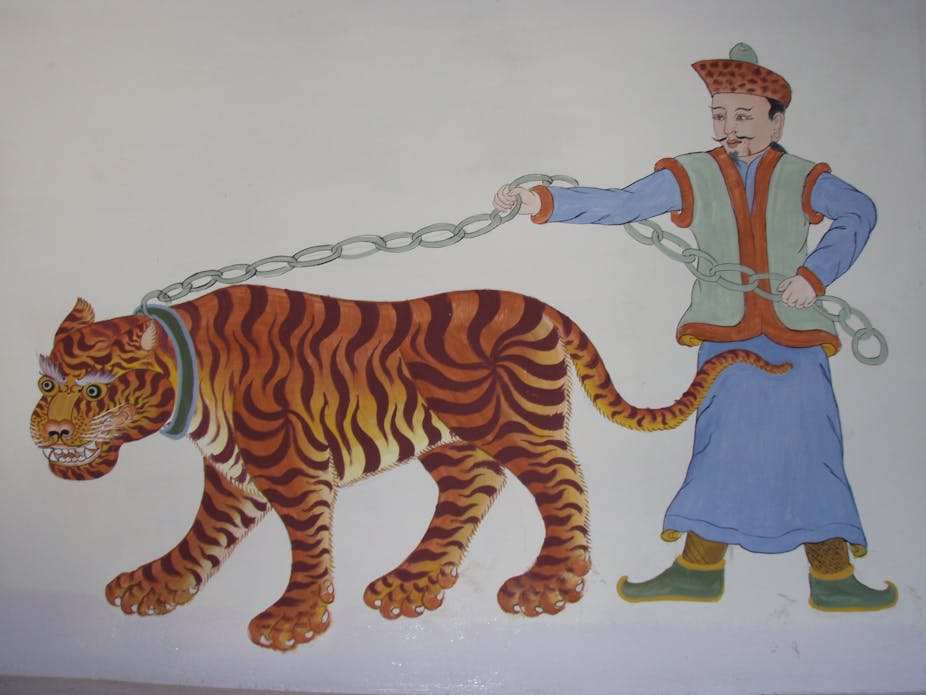Residents of Zanesville, Ohio, woke to the news today that most of the bears, wolves, lions and tigers that had been roaming free in their neighbourhood had been shot by police.
Police believe the animals were released en masse by the owner of a local private zoo just before he took his own life.
Among the animals shot were the private zoo’s 18 Bengal tigers (Panthera tigris tigris), a globally endangered species whose numbers are dwindling in the wild. The latest estimate for India, the species’ stronghold, puts the wild population there at less than 1,500 animals.
In Bhutan, where I work with colleagues on tiger conservation, population estimates range between just 67 and 81 tigers. Globally, there are less than 2,500 Bengal tigers, and possibly fewer than 3,200 tigers of any sub-species living in the wild today.
So, the news that 18 Bengal tigers were shot in a small town in Ohio overnight seems to be a real blow to the species. But that depends on just how many of these animals there are in captivity.
How many captive tigers are there?
In Australia, regulations on keeping exotic animals are tightly controlled under federal legislation (such as the EPBC Act) and state legislation (such as NSW’s Non-Indigenous Animals Act).

These regulations make it difficult, if not impossible, to import exotic animals and keep them in a private zoo.
Australian zoos do import exotic animals, but they do so as part of a tightly controlled and coordinated breeding effort. These efforts are aimed at conserving the species in captivity and maintaining a strong genetic line. Even then there are many hurdles to jump.
For example, the many months of work that led to Taronga and Melbourne zoos importing eight Asiatic Elephants to Australia produced a stack of paperwork that was apparently more than a metre high.
Before importing animals such as elephants and tigers, a zoo must demonstrate the educational and public benefit value of the animals, and that they will not pose a threat to people, agriculture, or the environment.
Having a private zoo in Australia, closed to the public and for the amusement of the owner (such as was apparently the case with the zoo in Zanesville) simply would not fly.
Because of our strict laws, there are only 65 tigers in Australian zoos (both public and private) that are accredited by the Zoo and Aquarium Association (ZAA).
Most of these (49) tigers are the Sumatran sub-species. Add to this the few more that are owned by circuses, small zoos and parks not ZAA-accredited, and you could probably say there are fewer than 80 tigers living in Australia right now.
How does this compare to the USA?
In the US, wildlife laws vary greatly from state to state, and some – Ohio included – have very relaxed laws regarding the keeping of exotic species.
Owning your own pet tiger is, apparently, possible. A 2011 survey of captive tigers by the Feline Conservation Federation revealed 2,884 “pet” tigers in the USA – a number that rivals the world population of wild tigers.

Only a small number of these (about 400) are in zoos listed by the accreditation body: the Association of Zoos and Aquariums (AZA). Most tigers are held by small sanctuaries and nature centres not accredited by the AZA.
The rest are found in circuses, as part of stage and travelling exhibits, as mascots for schools and universities, and owned by private individuals.
What’s the conservation value of all these tigers?
The value of nearly 3,000 captive American tigers is, sadly, very low; they are not likely to contribute much to global efforts to conserve tigers.
Zoos that aren’t members of the AZA will not be part of a global effort to maintain the genetic integrity of the species in captivity, so their captive tigers probably have questionable genetics.
To make matters worse, in 1998 the United States Department of Agriculture (USDA) enacted the “Generic Tiger Rule”. This rule exempted “generic” tigers – those not held by AZA-accredited zoos – from needing permits or being bound by the reporting requirements to which endangered species generally apply.

This also meant that individuals and organisations could interbreed the different sub-species of tiger to yield the sorts of animals the public love to see. Such animals include white tigers and the “golden tabby”, both very rare to non-existent in the wild, but on the increase in America.
Such genetic manipulation clearly has no value for the preservation of the species.
However, the tigers most people see in zoos – either in Australia, or large public zoos in the USA and elsewhere – are important for conservation of the species, and form part of carefully managed breeding programs.
They do an enormous amount of “public good” too, showing people what a magnificent product of evolution the tiger truly is, and by raising public awareness about the serious plight of wild tigers.

